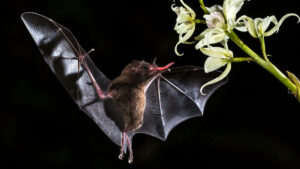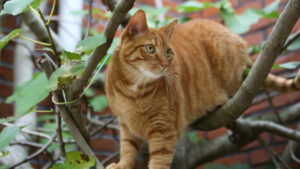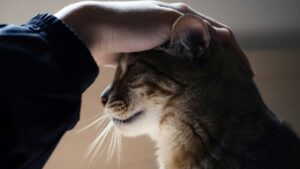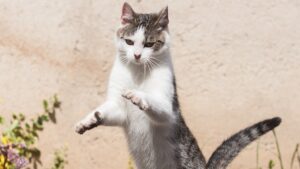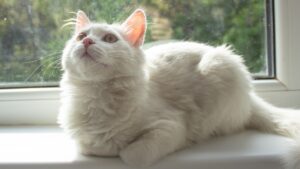Cats, those charming, inscrutable creatures, have been puzzling us humans for centuries. While they possess an aura of regal indifference, there’s one behavior that seems to unravel their cryptic nature — the purr. Have you ever wondered why your cat serenades you with that soothing purr? Well, you’re not alone in this quest for feline knowledge. In this article, we’ll explain the reasons why cats purr — and gain a better understanding of the feline symphony.
What is a cat purr — and how does it work?
First things first — what is a purr, and how does it work? It’s not some mystical spell or a hidden language. No, it’s good old physics at play! Cats produce the purring sound by rapidly contracting and relaxing the muscles in their larynx (voice box). It’s like a cat-sized concert where the vocal cords are the stringed instruments, and the air passing through them creates the melody. So, when your feline friend starts purring, it’s their way of strumming the vocal cords (and “heartstrings”) to create a symphony of relaxation and affection.
Happiness and contentment

Ah, the sweet sound of a purring cat, a surefire indicator of feline euphoria! Cats often purr to express their sheer happiness and contentment. It’s like their way of giving you a five-star review for being the best cat parent in the world. When they’re nestled in your lap, gazing at you with half-closed eyes, and emitting that melodious purr, it’s their version of a heartfelt “thank you.” They’re saying, “Life couldn’t get any better than this moment right here.”
Soothing pain, anxiety, and hunger
You might have heard that cats purr when they’re content, happy, and relaxed. And that’s often the case! But don’t let those innocent, fluttering eyelashes fool you. Cats have a few more tricks up their furry sleeves. They can purr when they’re in pain, anxious, or even hungry, per Forbes. It’s a stealthy little way of saying, “Hey, something’s not quite right here, human. Pay attention!” When your kitty purrs while you’re trying to groom her, it might not be all sunshine and rainbows.
Healing powers of the purr
Now, here’s where the purr gets seriously intriguing. Some studies suggest that the low-frequency vibrations generated by a cat’s purr might have therapeutic effects. It’s like having a mini-massage therapist on four paws. These vibrations could help reduce stress, lower blood pressure, and even promote the healing of bones and tissues. Move over, expensive spa treatments — cats are the original relaxation gurus!
Making a bond
You know that warm, fuzzy feeling when your cat curls up on your lap, purring away contentedly? It’s more than just a sweet moment — it’s a bond in the making. Kittens start purring when they’re just a few days old, signaling to their mother that they’re okay and cozy. This early communication tool sticks around as they grow, helping them bond with their human companions. When your cat purrs in your presence, it’s like them saying, “You’re family now!”
Multilingual purr
If you thought all purrs sounded the same, think again! Cats have a few different purring dialects. There’s the “I’m happy and relaxed” purr, which is like a gentle lullaby. Then there’s the “I’m hungry, and you better feed me” purr, which has a hint of urgency and annoyance. And let’s not forget the “I’m in pain, please help” purr, which is often more high-pitched and frantic. Pay attention to that subtle vibration, for your cat might be trying to tell you something specific.
Cat persuasion: Jedi mind trick
Cats have a knack for getting what they want, and the purr can be their tool of persuasion. Need proof? Just try to resist that adorable face and rhythmic purring when they want treats or access to the forbidden territory (aka your closet). It’s like a Jedi mind trick for cat lovers. You might start with a firm “no,” but those purrs can wear down even the most resolute human.
Release of ‘feel good’ chemicals in the brain
Now, let’s go even deeper into the science behind the purr. Some experts believe that cats purr to release endorphins, those natural feel-good chemicals in the brain. It’s their way of self-soothing, like a built-in stress relief mechanism. When you’re stuck in traffic or facing a mountain of emails, maybe try a little purring (although I can’t guarantee it’ll have the same effect).
Reasons why cats purr
In the grand scheme of things, why do cats purr? Well, it’s a complex phenomenon, akin to a multifaceted gem glistening from various angles. Cats purr to communicate, to heal, to bond, and sometimes just because they feel like it. In “cat-speak”, they’re saying “I’m here, I’m happy (or not), and I’m a mystery wrapped in fur.” Embrace the purr, decode its nuances, and let your feline friend serenade you with their unique melody.
Cats are like the James Bonds of the animal kingdom — mysterious, charming, and occasionally a bit mischievous. Their purr, that delightful and vocal charm, is just one more layer to their irresistible allure. In the presence of a purring cat, relish the moment, because it’s not just sound — it’s a symphony of emotions, a secret code, and a reminder that you’ve been chosen as a trusting companion. Keep decoding the purr, and you’ll unlock even more of the delightful mysteries that make cats such enchanting companions in our lives.
RELATED: New Cat Pain Detector App Tells Humans When Their Cat Is Suffering
Header image: White cat / Reanimated Man X via Unsplash
I’m Mark Putzer, and my passion for animals and all things nature is a life-long love affair. Growing up in Wisconsin, I had many cherished memories of hiking, skiing, and enjoying the abundant wildlife in the Badger State.
My passion for animals led me to marine biology research for my studies at the University of Wisconsin. I researched the behavior and communication of humpback whales around Hawaii and Orca Whales around the San Juan Islands of Washington State. The experience of being close to these massive and magnificent creatures is amazing. Later, I taught outdoor education to children in California — passing along my knowledge of animals and nature to the curious minds of the next generation. I also love pets. This includes a Labrador Retriever dog named “Molly” when I was a kid — and now, an adventurous tabby cat named “Rosy.”
I’m here to share the wonders of the animal kingdom with you. Whether it’s a cherished pet at home or an animal out in the wild, there are many unique stories and interesting information to share on Weird Animal News! Enjoy!


